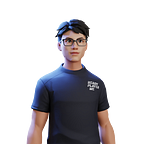Challenge Your Habits
Everyone has the tendency take the easy way. It’s just human nature.
The so-called “path of least resistance” is the way our minds are programmed to act and behave in default.
Given a choice between standing and sitting, most will choose to sit.
Given a choice between sitting on the couch watching TV versus declutter and cleaning up the house, I don’t even think there’s a point in arguing how the results will be.
This is just the way things are … “IF” there is no control of one’s own mind.
What motivates (pushes) us
To try new things, do hard things, take on new challenges?
We do things for a variety of reasons. It can be to take care of others (contribution) or because it is fun (enjoyable) for ourselves.
The next time you manage to achieve a result by yourself for yourself, pause and think. Why did you choose to do this activity, and how was it achieved.
For example — one of the routines I wanted to practise was taking cold showers. So, I started by taking cold showers after exercising and getting all sweaty, and naturally it felt great. But if I did not do my exercises prior, it would not be a pleasant experience, the water was too cold for my liking. But since I also did not want to be exercising everyday, there needed to be another way to make this activity sustainable for the long term.
I discovered that there is a point of balance and we just need to find where it is, in order to create an activity for the long term, making it into a habit. In my cold shower example, the point of balance was to “warm up” the body sufficiently before taking the cold shower. This means I do not need to do a 30 mins workout session or go for 5km run before the shower. A simple stretch and some basic exercises such as push ups, sit ups, squats, etc will be sufficient. These help to increase the heart rate slightly and warm up the body enough to take on the challenge of the cold shower.
The need to get stronger
There is a theory of “use it or lose it” which states that we need to keep using our mental and physical functions in order to maintain their capability. The body (and brain) will choose to weaken the parts which do not prove to be useful.
By going to the gym and carrying the weights, we are training our bodies to grow so as to be able to take on more weights and do more repetitions in future when we need the strength and power.
By running, we are forcing the heart and blood vessels to pump blood and oxygen throughout the body harder, thereby strengthening these vital systems within our bodies.
By solving difficult mental problems (worksheets), it is giving the brain a challenge and building more neural network linkages, promoting growth.
By taking control of our daily activities via thoughtful planning and strategy, we help ourselves take control of our own minds, and build the discipline and systems necessary to take on tougher challenges in future.
Without a disciplined and focused effort towards purposeful activities, the mind will just try to take “the easy way out”.
Working on challenges
It is hard to do things without a purpose, so we can create a “fake purpose” for ourselves. Instead of relying on other people to tell us what to do, where to go, what to eat, we can identify the direction we want to go towards.
The direction (path) to travel is a simple concept. Don’t confuse it with big concept words such as “mission statement” or even “goals”.
The big ideas and concepts can sometimes be so large and daunting that people don’t even want to try taking the first step, because there is a fear of failure, already thinking that it is unlikely to succeed even before starting.
An easy way to start is to use do the activities like a game system. This can also be called “gamification”. We can offer rewards when certain tasks are done or milestones are reached. This can help motivate the behaviour and remind us why we want to do such activities even though they may be hard.
When we are able to push ourselves to do things that take effort (more than usual), the process helps us grow. It helps us identify the potential we have because by taking control of the mind, we go on to re-discover our limits, and keep striving to stretch them. This is sustained growth from planned execution. Some authors also term it as “mindful practice” or “practice with a purpose”.
Helping the children to learn better
Childhood is the best time to teach about mental strength and resilience. It is also the hardest period of one’s life to understand the concept. The brain of pre-teens is not developed enough to be able to be in total control of one’s actions and desires, and that’s why children will always act according to their moods.
When they are happy, they want to play, learn, have fun. If they are hungry, they want to eat, if they are tired, they want to nap. The performance of tasks is based on how they feel in the immediate moment, instead of a following a planned schedule.
Guiding children on the basic concept of forgoing immediate gratification for greater future rewards will benefit them greatly as they grow older. Some people may actually call it “discipline”. This powerful trait becomes ingrained in them and allows them to have self-control as early as possible.
Using creative reward systems, adults can formulate specific tasks that are beneficial for children to develop as good healthy habits, without the hassle and fuss of constant nagging and punishments.
